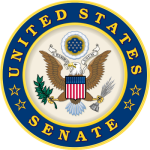- 産業: Government
- Number of terms: 4127
- Number of blossaries: 0
- Company Profile:
The United States Senate is the upper house of the United States Congress. The composition and powers of the Senate are established in Article One of the U.S. Constitution. Each U.S. state is represented by two senators, regardless of population. Senators serve staggered six-year terms.
A proposed law passed by Congress must be presented to the President, who then has 10 days to approve or disapprove it. The President signs bills he supports, making them law. He vetoes a bill by returning it to the house in which it began, usually with a written message. Normally, bills he neither signs nor vetoes within 10 days become law without his signature.
Industry:Government
The principal vehicle employed by lawmakers for introducing their proposals (enacting or repealing laws, for example) in the Senate. Bills are designated S. 1, S. 2, and so on depending on the order in which they are introduced. They address either matters of general interest ("public bills") or narrow interest ("private bills"), such as immigration cases and individual claims against the Federal government.
Industry:Government
From the Algonquian Indian language, a caucus meant "to meet together. " An informal organization of Members of the House or the Senate, or both, that exists to discuss issues of mutual concern and possibly to perform legislative research and policy planning for its members. There are regional, political or ideological, ethnic, and economic-based caucuses.
Industry:Government
The Parliamentarian is the Senate's advisor on the interpretation of its rules and procedures. Staff from the Parliamentarian's office sit on the Senate dais and advise the Presiding Officer on the conduct of Senate business. The office also refers bills to the appropriate committees on behalf of the Senate's Presiding Officer.
Industry:Government
When the Chair rules on a point of order, any Senator may appeal the ruling, in which case the full Senate makes a final decision on the point of order by voting whether to sustain or reverse the ruling.
Industry:Government
An amendment that would strike out the entire text of a bill or other measure and insert a different full text.
Industry:Government
An adjournment of the Senate that fixes the day and time for its next session.
Industry:Government
A legislative measure, designated "S. Con. Res. " and numbered consecutively upon introduction, generally employed to address the sentiments of both chambers, to deal with issues or matters affecting both houses, such as a concurrent budget resolution, or to create a temporary joint committee. Concurrent resolutions are not submitted to the President and thus do not have the force of law.
Industry:Government
A Federal program or provision of law that requires payments to any person or unit of government that meets the eligibility criteria established by law. Entitlements constitute a binding obligation on the part of the Federal Government, and eligible recipients have legal recourse if the obligation is not fulfilled. Social Security and veterans' compensation and pensions are examples of entitlement programs.
Industry:Government
The Constitution grants the President 10 days to review a measure passed by the Congress. If the President has not signed the bill after 10 days, it becomes law without his signature. However, if Congress adjourns during the 10-day period, the bill does not become law.
Industry:Government
